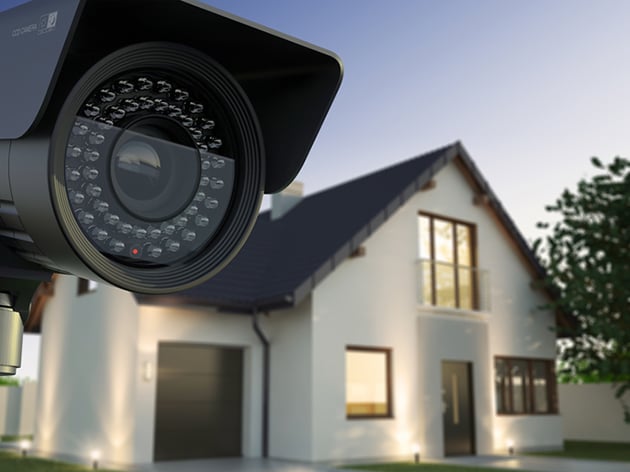Your Cart is Empty
Gate Season is in Full Swing with our Lockey Spring Sale Collection | Shop Now!
Categories
Industry
Where to Place Security Cameras at Home

Gone are the days where at-home security surveillance is inaccessible to the average homeowner—as equipment was far too expensive and typically required professional installation. With an increase of home surveillance equipment, you now have access to high-quality video surveillance systems that will no longer break the bank, allowing you to protect your home and the people you love the most.
If you’re looking to invest in home security, you may wonder how home security cameras work to protect your family. Most security camera systems operate by detecting motion that triggers video recording and saving that recorded footage to either local storage (i.e. memory card) or cloud storage. With so many at-home security cameras on the market, it’s helpful to know what types of options are in your budget and how to install security cameras by yourself.
Different Types of Home Security Cameras
Doorbell Surveillance Cameras
Doorbell cameras have become an incredibly popular option for homeowners looking to improve the security of their homes. These advanced doorbell cameras, like the August Doorbell Cam Pro, capture motion and even allow you to see and speak to any visitors. These devices typically require Wi-Fi internet connection and a Bluetooth-ready smart device, which helps you conveniently monitor your home, even from far away.
Wireless Security Cameras
Wireless capabilities are incredibly convenient, and wireless security cameras like the VistaCam 700 are great options for interior surveillance. Without needing to directly connect to a digital video recorder (DVR) or a network video receiver (NVR), your camera wirelessly communicates with a transmitter that allows the DVR/NVR to store the captured video. The camera and the DVR/NVR both need to be plugged into a power outlet, but the wireless capabilities eliminate the need for a cable or ethernet wire, though some models offer the option for ethernet connectivity. A good Wi-Fi signal is required for these cameras.
PoE Security Cameras
An incredibly efficient camera system, cameras with Power over Ethernet (PoE) technology, like the weatherproof VistaCam 1101, allows ethernet cables to provide the camera with power and connectivity to the NVR, where captured footage is stored. Ethernet cables provide the highest quality video capturing and are a great option for your exterior surveillance.
Tips on How to Install Security Cameras Outside Your Home
The most important step in installing a video surveillance system at home is to take time to consider your security vulnerabilities. These will vary depending on your particular home and property, but essentially, take note of the various entry points that intruders may consider “an opportunity.” Here are some common entry points that may benefit from surveillance:
- Front door
- Back door (or sliding glass door to deck)
- Garage
- Side door
- Walk-in basement door
- Lower windows
By following these pro tips on outfitting the exterior of your home with security cameras, you can ensure your home and family are getting the most out of your surveillance:
- Place cameras at entry points or areas of security vulnerability—While having all entry points under surveillance is ideal, be sure your main entry points (i.e. front door, back door, etc.) are outfitted with security cameras.
- Install cameras higher up—By installing your camera at least nine feet from the ground, you’ll get a larger field of view, while also reducing the likelihood of a potential intruder damaging or covering your camera. Be sure to consider angling the camera to have a complete view with the ground and entry point well within frame.
- Keep cameras sheltered & unobstructed—It’s important to confirm you have a clear, unobstructed view to capture motion accurately. Placing your camera under shelter and away from obstructions allows the camera to capture the highest-quality video, without the influences of weather, sunlight, or blind spots.
- Stay within range—If you’re installing cameras requiring Wi-Fi, you’ll want to place the cameras within the products’ specified range limit and within your strong Wi-Fi signal range to ensure high-quality video recordings.
- Consider installing an imitation camera to deter intruders—It may interest you to install a decoy camera in plain sight to help deter intruders while keeping your functioning surveillance cameras hidden. If intruders see advanced security features like camera surveillance, they’re likely to avoid the risk of getting caught. Having your other security cameras out of sight still ensures you’re capturing any movements and attempts.
Update Your Home’s Security with GoKeyless
If you’re considering improving security for your family and your property, consider installing a home security camera system. GoKeyless offers top-of-the-line home security surveillance equipment that gives you peace of mind, knowing you and your loved ones are well protected.
Browse by Category
© 2025 GoKeyless. All rights reserved. Privacy Policy. Terms of Use. Powered by Brandography.



 Over 5 Million Locks Sold
Over 5 Million Locks Sold Trusted Since 2003
Trusted Since 2003 Help
Help
